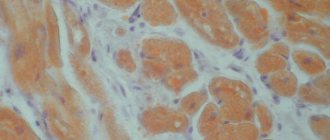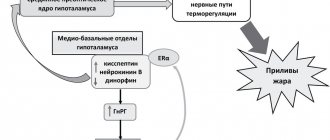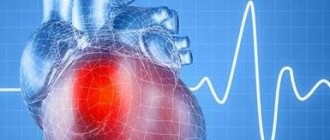Medical editor: Strokina O.A. - therapist, functional diagnostics doctor. November, 2021.
Early ventricular repolarization syndrome (EVRS) is a medical concept that includes only ECG changes without characteristic external symptoms. It is believed that SRRS is a normal variant and does not pose a threat to the patient’s life.
However, recently this syndrome has become viewed with caution. It is quite widespread and occurs in 2-8% of cases in healthy people. The older a person gets, the less likely it is that he or she will have SRR; this is due to the emergence of other cardiac problems that are similar in electrocardiographic signs as they age.
Most often, early ventricular repolarization syndrome is diagnosed in young men who are actively involved in sports, in men who lead a sedentary lifestyle, and in people with dark skin (Africans, Asians and Hispanics).
What it is
The human heart consists of 2 types of cells - typical cardiomyocytes (muscle cells that provide contraction) and atypical cardiomyocytes (generating and conducting nerve impulses).
Thanks to the activity of the latter, the heart is capable of constant and rhythmic contraction. This is called automaticity. At the moment when the heart is at rest (not contracting), positively charged particles (cations) are located outside the cardiomyocyte membrane, and negatively charged particles (anions) are located inside.
When ions begin to move through special channels, the charge of the membrane changes (inside to “+”, outside to “-”). As soon as the charge difference reaches a certain value, an excitation wave is generated (depolarization occurs), which is transmitted to the muscle cells, and the heart contracts. Then the ions return to their original place (the myocardium relaxes), and the cycle repeats again. This moment of reverse movement of ions is called repolarization.
Repolarization disorder is a very common phenomenon among both adults and children (more often in males). Moreover, it can be observed both in absolutely healthy people and in those who suffer from severe cardiac diseases.
A special type of this pathology is distinguished - early myocardial or ventricular repolarization syndrome (ERRS) , which is mainly found in adolescents and even newborns who do not have any heart disease. SRS can also be found in adults.
Description of the cardiac cycle
The contraction of the heart is caused by electrical impulses that are conducted to each cell of the myocardium (heart muscle). After receiving such an impulse, each cardiomyocyte goes through a stage of contraction and relaxation, which constitute the cardiac cycle. However, behind each of these stages there is a complex mechanism for the flow of calcium, potassium and chloride ions out of and into the cell. The electrical changes in the membranes of cardiomyocytes that underlie contraction are called depolarization, and those that underlie relaxation are called repolarization.
Click on photo to enlarge
Causes
The exact cause of disturbances in repolarization processes is unknown. Pathology can develop under the following conditions:
- Autonomic dysregulation syndrome – better known as vegetative-vascular dystonia;
- organic heart diseases - coronary disease, myocarditis, heart failure, cardiosclerosis, cardiomyopathies, thickening of the interventricular septum;
- the use of drugs that affect the excitability or metabolism of myocardial cells - antidepressants, adrenergic agonists, psychostimulants, cardiac glycosides;
- connective tissue dysplasia is a hereditary pathology characterized by insufficient production of collagen protein and manifested by joint hypermobility, increased skin extensibility, and impaired metabolic processes in the myocardium;
- changes in the blood levels of electrolytes - sodium, potassium, calcium, magnesium;
- Excessive physical activity – SIRD is common among athletes.
QT shortening
The syndrome is also very rare and may be associated with certain congenital diseases with gene mutations. Improper functioning of potassium channels leads to changes in QT duration. The shortened repolarization process is accompanied by constant arrhythmia, and the risk of sudden cardiac arrest always remains.
Short QT syndrome
Factors that allow diagnosing a shortened repolarization phase:
- Frequent attacks of arrhythmia and ventricular tachycardia, fainting.
- Sudden slowing of heart rate at any time of the day.
- ECG data. If the QT duration is less than 0.33, then this pathology will most likely be confirmed.
- Heredity. If there have been cases of sudden cardiac arrest in your family, there is a risk.
In children, the shortened repolarization process occurs in the same way as in adults. A qualified diagnostician may suspect this disease even if there are no direct symptoms.
Non-cardiac symptoms of short QT phase:
- elevated potassium or calcium levels in a blood test;
- elevated temperature;
- the initial stage of acidosis (the pH level is shifted to the acidic side);
- Digoxin use.
Possible manifestations and consequences for the body
As a rule, if repolarization is disrupted, nothing bothers a person. Therefore, in almost everyone, this syndrome is detected either during a preventive medical examination or during examination for another disease.
If symptoms appear, then only if a repolarization disorder occurs against the background of some kind of cardiac pathology. Then the patient may complain of heart pain, dizziness, rapid pulse, etc.
I am often asked whether impaired myocardial repolarization is dangerous, especially during pregnancy. No, but it may indicate the presence of cardiac disease.
As for SRRH, for a long time it was considered absolutely harmless, it was taken for an “accidental find”. However, many years of clinical studies have cast doubt on this.
It turned out that those people who had signs of SRR on the ECG have a very high risk of developing paroxysmal supraventricular tachycardia, atrial fibrillation and Wolff-Parkinson-White syndrome in the future (in a few years).
How are phase changes monitored on a cardiogram?
Pathological disturbances of repolarization provoke changes in the ECG curve of the height of the T wave. However, it is impossible to make an accurate diagnosis - this phenomenon is observed not only in heart diseases, but also in any metabolic disorders. If a shift in the ST segment is also observed, this indicates an imbalance in the electrolyte balance in the cells. The repolarization process can be disrupted by a serious pathology - hypersympathicotonia, accompanied by an increase in the level of adrenaline in the blood.
Many people have pathological changes in the lower wall of the heart muscle, completely unaware of it - such processes are caused by heavy physical labor, constant stressful situations, hormonal disorders and aging of the body
This condition is caused by an increase in the tone of the sympathetic department of the autonomic system and causes:
- decreased sweating, secretion of saliva and mucus;
- dry skin;
- tachycardia;
- painful sensations in the heart;
- noticeable change in mood;
- increased blood pressure.
How deviations are determined
The main and only method for diagnosing ventricular repolarization disorders is electrocardiography. The film shows nonspecific changes in the T wave (mainly in the chest leads) - it becomes high, pointed, or, conversely, its amplitude decreases, it may be negative.
Of much greater interest is the ECG diagnosis of SRGR, in which the following main signs are noted:
- ST segment elevation;
- point j, “camel hump”, “Osborne wave” – a notch on the descending part of the ST segment;
Shortening of the PQ and QT intervals may also occur.
Decoding the cardiogram requires special care from the doctor, since ST segment elevation occurs in other, more serious pathologies - angina pectoris, myocardial infarction, pericarditis, etc. Most often, the clinical picture does not help in differential diagnosis, because SRS is not accompanied by any symptoms.
However, if I find the above changes on film in an adult (especially after 40 years), then I additionally prescribe stress tests, i.e. taking an ECG while the patient is performing moderate physical activity - on a bicycle ergometer or treadmill (treadmill). With SRRH, the cardiogram returns to normal. This helps me make a differential diagnosis between the silent form of angina and heart attack.
In case of an unclear ECG picture, I use special tests with drugs. The patient is administered potassium chloride or Novocainamide. After 30 minutes, an ECG is taken. With SRR, the signs become more distinct.
To detect possible arrhythmias, I perform daily (Holter) ECG monitoring on my patients.
Since SRHR can develop against the background of organic heart disease, I prescribe echocardiography to assess the morphological structure of the myocardium.
QT prolongation
The cause of this phenomenon is most often a hereditary factor; genetic changes are accompanied by improper functioning of ion channels. The case is quite rare, occurring once in 6-7 thousand people. Due to an imbalance of ions in the cells of the heart muscle, the excitation process is prolonged, which is reflected in the cardiogram.
ECG changes in various types of long QT syndrome
Such a deviation from the norm can appear at any age. The clinical picture is as follows:
- Sudden rapid heartbeat without any reason. On the ECG, this process is displayed as ventricular tachycardia with changes in the shape of the QRS complex.
- An increased QT interval may occur due to a surge of emotions (both positive and negative), or be a consequence of taking medications.
- Sudden fainting.
In a child, deviations in the repolarization process may be accompanied by the symptoms listed above, or may not appear at all. It is extremely important to establish such a disorder in time, since the syndrome can lead to sudden death.
Treatment and proper observation
There is data on the use of so-called “energotropic” drugs (Carnitine, Kudesan), which normalize metabolic processes in the myocardium. However, repolarization disorders themselves usually do not require treatment.
I prefer to pay more attention to the conditions and pathologies that caused the disorders, and if they are identified, direct therapeutic measures (medicinal and non-medicinal) to eliminate them.
In the absence of any illnesses, it is necessary to regularly see a doctor in the future. At least once a year, undergo a minimum cardiological examination - face-to-face examination, ECG, Holter monitoring.
In case of long-term course of SRR, to prevent the occurrence of arrhythmias, I use magnesium preparations, less often - antiarrhythmic drugs (Amiodarone).
If life-threatening arrhythmias occur, radiofrequency ablation may be necessary.
Treatment of early ventricular repolarization syndrome
Repolarization syndrome does not require specific treatment. The only thing that is offered to the patient is observation by a cardiologist.
However, a person with SRS should avoid alcohol consumption and intense physical activity to avoid triggering an attack of tachycardia.
In some cases, radiofrequency ablation of an additional beam is performed in an invasive way (a catheter is brought to the site of the beam and destroys it).
Sometimes energotropic therapy (B vitamins, carnitine, phosphorus and magnesium preparations, Mexidol, Kudesan), antiarrhythmic drugs (amiodarone) are used.
Important! The patient should retain all previous ECGs, which is required to exclude the diagnosis of myocardial infarction if heart pain occurs.
Clinical case
I recently observed a patient who came to me with complaints of difficulty breathing, which worsened when walking, climbing stairs, and at night.
He has been suffering from arterial hypertension for several years. I did not receive any treatment. During a general examination, an increased heart rate of up to 126 per minute and high blood pressure of up to 150/95 mmHg are noted. Art., swelling of the feet and lower thirds of the legs, enlargement and tenderness of the liver upon palpation. An ECG was performed. interpretation - sinus tachycardia, diffuse disturbances in the processes of repolarization of the left ventricular myocardium, signs of left ventricular hypertrophy. The patient was referred for echocardiography. Holter monitoring revealed no other pathological abnormalities. The result is hypertrophy and dilatation (expansion) of the left chambers of the heart, a decrease in the ejection fraction of the left ventricle - 55%. A clinical diagnosis was made: “Chronic heart failure stage IIB, functional class II according to NYHA. Background disease: Stage III hypertension, stage 2 arterial hypertension.” Treatment was prescribed: limiting salt intake to 3 g per day, Bisoprolol 5 mg once a day, Perindopril 10 mg once a day, Amlodipine 5 mg once a day.
Diagnostics
Cardiac electrocardiography (ECG) is used to diagnose the correct processes of depolarization and repolarization.
The teeth and intervals mean nothing to the layman. Functional diagnostic doctors are familiar with subtle signs and changes in characteristic waves and can calculate the time of repolarization.
An increase in the depolarization time of the ventricles of the heart indicates a mechanical obstacle in the propagation of the impulse. This is possible with blockades of varying degrees. Acute infarction most often affects the left ventricle. Here a connective tissue scar is formed, which serves as an obstacle to the impulse. At the conclusion of the ECG, the doctor, in addition to signs of a heart attack, will definitely write about a moderate depolarization disorder.
When deciphering, the shape of the complexes, the height and width of the teeth, the level of the main line, and the duration of the intervals are taken into account
Impaired repolarization is indicated by a decrease in the T wave. This is typical for diffuse dystrophic changes and cardiosclerosis. In this case, the ECG conclusion does not make a diagnosis, but helps to understand the mechanism of formation of symptoms of the disease, stage and form.
Repolarization is disrupted by myocardial hypertrophy, taking certain medications, lack of microelements and vitamins in the diet, and dehydration. Such a patient should be examined in a hospital and a stress test with potassium chloride should be performed. After potassium administration, the ECG shows normalization of the shape of the ventricular complexes.
Structure and diagram of the heart
The human heart is divided into 4 chambers. The upper pair is usually called the atria, and the lower two are called the ventricles. The atria push blood directly into the ventricles, from where it goes to the lungs and then to the rest of the organs. The palpitations observed during diagnosis are due to contraction of the ventricles. Heart rhythm is regulated by the conduction system of the heart.
The heart is “started” by an electrical impulse. It is formed from multiple electrical currents from the junction of heart cells
This system includes the following components:
- sinus and atrioventricular nodes;
- special tissues of the ventricles that allow the passage of electrical impulses.
The sinus node, which acts as a direct regulator of heart rate, is a small area of cells concentrated in the lower wall of the right atrium. The frequency of electrical impulses released by the sinus node determines the heart rate in a healthy state.
In a non-excited state, the frequency of impulses conducted by the sinus node is low, which helps maintain the heart rate in the lower normal range (a total of 60–80 beats per minute).
During physical activity, during periods of emotional stress or increased excitability, the frequency of impulses increases significantly. The exception is athletes; their normal heart rate is usually about 45 beats per minute.
Electrical impulses pass into the atrioventricular node and through it eventually to the ventricles, which leads to their contraction.
The heartbeat becomes possible when an electrical impulse occurs in it. The myocardium regularly contracts and relaxes through two important stages: depolarization and repolarization.
Depolarization is the process of changing a negative charge to a positive one. The resulting impulse is transmitted at a predetermined speed to the cells in the neighborhood and directly to the myocardium to enable its contraction to occur. Depending on the number of healthy cells, changes in wave speed occur along the path of the electrical impulse.
The detection rate of early repolarization syndrome ranges from 1 to 9%. It is found 3 times more often in men.
Repolarization, in turn, is a process that covers a slightly longer time interval than the previous one, which carries out a reverse charge change and contributes to the concentration of the portion of energy necessary for subsequent contraction in the myocardium.
Noticeable changes in heart rate, accompanied by a deterioration in general health, are a direct route to the cardiology center. There are many methods for diagnosing disorders of the cardiac system. Electrocardiography is one of the simplest, most accurate and informative methods for studying the functioning of the main organ of the human body.
An ECG study is carried out using a special device with suction cups, which records electrical impulses and displays the result on a moving tape in the form of a curve and visible teeth, concavities, narrownesses and asymmetries. You should not panic when you see a conclusion about the detection of early repolarization of the ventricular myocardium, because it is important to prevent possible complications and the occurrence of serious diseases.
The following changes are recorded on the electrocardiogram:
- the descending limb of the scar R is jagged;
- the ST segment is raised above the isoline.
The syndrome is detected equally in both sick and healthy parts of the population and may not be accompanied by any symptoms, therefore, in case of unhealthy manifestations of cardiac activity and for prevention, it is recommended to undergo immediate diagnosis in a hospital in order to prevent complications in the work of the body’s “flame engine”.
Qualitative changes occur in the functioning of the ventricles: they contract prematurely and, as a result, blood flow deteriorates. The atria may also begin to function in a different mode: early repolarization usually takes the form of an increased heart rate.
We recommend that you familiarize yourself with a fairly wide list of factors that can provoke the syndrome:
- Taking certain types of medications, cytostatics (help slow down the process of cell division), glucocorticosteroids (synthetic substitutes for adrenal hormones), non-steroidal anti-inflammatory drugs (have analgesic, antipyretic, anti-inflammatory and antifever effects), adrenomimetics (cause an increase in heart rate, increase myocardial performance, including lowering blood pressure).
- Manifestation of paroxysmal supraventricular tachycardia.
- Attacks of atrial fibrillation src=»https://dp3.ru/wp-content/uploads/2019/08/7b1dd4e8233df9af6e3ede577bd9ae3b.jpg» class=»aligncenter» width=»600″ height=»381″[/img]
- Violation of the sequence of myocardial contractions or sudden occurrence of paired or single electrical impulses in the area of the atria or ventricles.
- Sedentary lifestyle and excess weight.
- Increased physical activity (especially in people actively involved in sports).
- Being in conditions of sudden temperature changes, hypothermia, overheating.
- Excessively elevated levels of fats (lipids and/or lipoproteins) in a person's blood.
Almost asymptomatic, but with a great threat to human health, disruption of repolarization processes in the myocardium accompanies a whole range of diseases:
- failure of cardiac circulation;
- proliferation and increase in muscle mass of the left ventricle of the heart, leading to a change in the appearance of the organ and its size or thickening of the interventricular septum (hypertrophy);
- increased blood pressure above normal levels (arterial hypertension);
- congenital or acquired heart defects;
- congenital pathology of the cardiac system;
- cardiac neurosis (neurocirculatory dystonia);
- chronic otorhinolaryngological diseases (chronic sinusitis, sinusitis, sinusitis, laryngitis, and a number of others);
- imbalance of sodium and potassium.
In addition to adults, children of all ages are also susceptible to heart problems. They may also experience negative changes in the functioning of the cardiovascular system for some trivial reasons:
- intensive growth, especially during puberty, resulting in incorrect development of chambers and vessels, narrowing of blood patency in the aorta and restriction of blood flow;
- increased physical activity and emotional stress;
- low resistance to stress and high levels of fatigue during the day;
The risk of repolarization in a child due to damage to the heart and other body systems is quite high; timely elimination is necessary.
Pathology can accompany a wide range of the following cardiovascular and some groups of other equally dangerous diseases:
- excess levels of thyroid hormones in the human body, known as hyperthyroidism;
- decreased thyroid function;
- decreased level of hemoglobin in the blood (anemia);
- chronic inflammation of the tonsils due to numerous sore throats (chronic tonsillitis);
- inflammation of the myocardium, in medical practice called myocarditis;
- neurosis;
- pneumonia;
- bronchial asthma.
Repolarization on the cardiogram is a signal about existing heart disease or the risk of its occurrence. There are no universal methods for eliminating repolarization in the myocardium. The attending physician prescribes individual treatment for the disease after careful monitoring of the heart organ, and as a result of recovery, the cardiograph will no longer show any suspicious changes on the tape.
When is treatment required?
The question of the need to treat disorders of repolarization processes should be resolved as soon as possible after they are detected on the cardiogram and further examination of the patient. In the absence of a causative cardiac pathology, the patient is prescribed medications or a pacemaker is installed, based on the presence or absence of clinical manifestations of tachyarrhythmias (fainting, tachycardia, heart failure).
Thus, due to the fact that short QT interval syndrome often leads to life-threatening ventricular tachyarrhythmias, all patients with this syndrome need to determine the indications for implantation of an electrical pacemaker (pacemaker) (cardioverter-defibrillator).
Patients with long QT syndrome require pacemaker implantation if they have a history of life-threatening arrhythmias or a high risk of sudden cardiac death (for example, there is a family history of sudden cardiac death at a young age for no apparent reason and without the presence of obvious cardiac pathology). If the risk is not great, it is enough for the patient to take a drug from the group of beta-blockers (BAB), for example, Concor, Egilok, Coronal, etc.
In case of early repolarization syndrome without other cardiac pathology (isolated ERR, for example, in athletes), it is enough for the patient to limit participation in sports events and competitions. If there is organic damage to the myocardium, a complex of necessary drugs is prescribed (nitrates for ischemic changes and angina pectoris, diuretics for heart failure, antihypertensives for hypertension, etc.).
Thus, short QT syndrome requires treatment in any case , and early repolarization syndrome and long QT syndrome require treatment when there are clinical manifestations of tachyarrhythmias in the form of fainting and/or a high risk of sudden cardiac death has been identified and/or there is any other heart pathology. But in any case, the treatment is completely selected by the attending physician, since self-medication can cause irreparable harm to health.
Classification and risk groups
There is the following classification of early repolarization syndrome:
- with damage to the heart muscle and blood vessels;
- there is no lesion.
The syndrome is also classified according to the degree of severity on the electrocardiogram into 3 classes:
- Minimal (observed in a small number of leads, from 2 to 3).
- Moderate (the number of leads increases from 4 to 5).
- Maximum (6 or more leads).
However, most often the disease appears during pregnancy or menopause in women, since at this time the sensitivity of the body increases significantly and the general hormonal background changes. The disease is detected, as a rule, during routine examinations, in case of any complaints about well-being.
Professional athletes who experience constant physical activity and people who have suffered from hypothermia are also at risk. And some doctors even claim that the disease is hereditary.
Why do repolarization disturbances occur?
Various reasons can change the ongoing process:
- Diseases of the cardiac and vascular systems - cardiosclerosis, left ventricular hypertrophy, vegetative-vascular dystonia, ischemia.
- Factors not associated with cardiovascular pathologies - hormonal disorders, dehydration, impaired renal function, pathologies of the nervous system, increased flow of excitation stage impulses to the heart.
Changes in the functional activity of mediators of adrenergic substances (adrenaline and norepinephrine) can cause some neoplasms. A pathological change in repolarization is observed with an increase in the QT segment, a decrease in the QT interval, and the syndrome of early termination of the excitation phase. Now we will dwell on each of them in detail.
The main reason for the improper functioning of ion channels is hereditary predisposition. This phenomenon is quite rare and occurs in one person in 6 thousand. Due to the influence of a genetic factor in the cells of the heart muscle, the balance of ions is disturbed, which leads to a prolongation of the excitation process. This disorder manifests itself at any age; its clinical signs are sudden and causeless tachycardia, displayed on the cardiogram as increased ventricular contractions with changes in the configuration of the QRS complex.
This condition is observed:
- with an emotional outburst;
- taking certain medications;
- sudden loss of consciousness.
Timely identification of deviations in the repolarization process in children is very important - this syndrome can cause sudden death
This deviation is also quite rare - its occurrence is associated with congenital anomalies and gene mutations. Changes in the duration of the QT segment are caused by improper functioning of potassium channels. It is possible to diagnose a shortening of the repolarization phase if the patient has a constant arrhythmia, fainting, frequent attacks of tachycardia, or a sudden slowdown in heart rate.
A qualified cardiologist may suspect the presence of this pathology even if “non-cardiac” signs appear: an increase in body temperature, an increase in the concentration of calcium or potassium in the blood, a shift in the pH level towards acidity, the use of the cardiac glycoside Digoxin. If the ECG records a QT interval duration of less than 0.33 seconds, this confirms a shortening of the repolarization process.
Until recently, this change was not considered a pathology. However, recent scientific research suggests that this disorder is considered sinus arrhythmia.
What does the T wave reflect on an ECG?
Today it is most common among young people who are actively involved in sports. There are no clear clinical symptoms of the disease, but there are a number of reasons that can cause it:
- excessive physical stress;
- changes in the balance of electrolytes in the blood;
- ischemic disease;
- prolonged hypothermia of the body;
- diffuse changes in the myocardium of one of the main chambers of the heart - the left ventricle;
- increased blood lipid levels;
- use of adrenergic stimulants;
- disturbances in the complex of anatomical formations of the heart muscle.
It is difficult to detect early repolarization, but practicing cardiologists believe that cases of tachycardia and sudden cardiac arrest are very common in people with this pathology.
Normal indicators and reasons for changes
With moderate intensity of the pathology, painful symptoms related to the functioning of the heart may not appear, so detection of deviations from the norm often occurs at advanced stages.
A cardiologist, conducting an examination if there is a suspicion of the development of disturbances in repolarization processes in the myocardium, studies the nature of the cardiogram waves and interval indicators.
Normal characteristics of teeth:
- Wave T. Directed upward (negative VR value).
- Wave Q. Normal value is 1/4 R (at 300 ms).
- R wave. Present in all leads.
- Prong S. Height – 2 cm.
- P wave. Positive value in the first two leads, negative VR value (100 ms).
Interval standards: QT – up to 400 ms, QRS complex – up to 100 ms, RR – 0.62/0.66/0.6 s, PQ – 120 ms.
In the absence of pathologies, the heart rate is from 60 to 85 beats per minute (sinus rhythm).
The process of repolarization is a state during which the initial (before contraction) potential of the cell membrane is restored and its electrical charge is restored. Nerve impulses (potassium ions) must leave the membrane, energy, enzymes and oxygen saturation accumulate in the cell.
That is, even at rest, biochemical mechanisms are activated in the membranes of nerve cells, without which normal functioning cannot be restored.
The interpretation of the electrocardiogram is very individual. The specialist must pay attention to many factors and indicators. It is almost impossible to independently determine the violation of repolarization processes, since in their presence several indicators are changed at once, and these changes may be insignificant or non-specific.
However, some deviations from the norm may be indicative when making a diagnosis. Some normal ECG readings:
- Teeth.
- T. VR - negative value. Pointed upward. If the indicator changes, hyper- or hypoglycemia may be present. The relationship of this tooth to others is of paramount importance for determining violations of repolarization processes.
- Q. The norm is 1/4 R at 0.3 sec. Enlargement indicates the presence of myocardial pathologies.
- R. Normal - determined at each lead. If absent, ventricular hypertrophy may be present.
- S. Normal height is 20mm. The ST segment is important.
- P. The first and second leads are positive. VR - negative. The norm is 0.1 s.
- Intervals.
- QT - up to 0.4 s.
- PQ - 0.12 s.
- RR – 0.62 – 0.66 – 0.6.
- QRS complex - up to 0.1 s.
- General information.
- Heart rate is within 60-85 beats per minute.
- The rhythm is sinus.
- Normal location of the electrical axis of the heart (without deviations to the right or left side).
Usually, in the conclusion, the specialist writes a transcript based on these indicators. But if the patient already has a diagnosis or is suspected of having one, more detailed data is indicated, where attention is paid to specific violations of certain indicators (for example, the length of specific teeth or intervals, distance from certain points).











